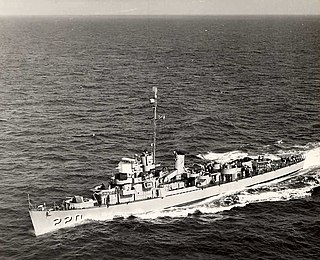I-52, code-named Momi was a Type C-3 cargo submarine of the Imperial Japanese Navy used during World War II for a secret mission to Lorient, France, then occupied by Germany, during which she was sunk.

USS Bogue (AVG/ACV/CVE/CVHE-9) was the lead ship in the Bogue class of escort carriers in the United States Navy during World War II. The ship was named for Bogue Sound in North Carolina.

USS Block Island (CVE-21/AVG-21/ACV-21) was a Bogue-class escort carrier for the United States Navy during World War II. She was the first of two escort carriers named after Block Island Sound off Rhode Island and was the only American carrier sunk in the Atlantic during the war.
Ro-45 was an Imperial Japanese Navy Kaichū type submarine of the K6 sub-class. Completed and commissioned in January 1944, she served in the central Pacific Ocean during World War II and was sunk in April 1944 during her first combat sortie.

USS Francis M. Robinson (DE-220), a Buckley-class destroyer escort of the United States Navy, was named in honor of Commander Francis M. Robinson (1883–1942), who was a recipient of the Navy Cross.

USS England (DE-635), a Buckley-class destroyer escort of the United States Navy, was named in honor of Ensign John C. England (1920–1941), who was killed in action aboard the battleship Oklahoma during the Japanese attack on Pearl Harbor on 7 December 1941. Her sinking of six Japanese submarines in twelve days is a feat unparalleled in the history of antisubmarine warfare.

USS Thomason (DE-203) was a Buckley-class destroyer escort in service with the United States Navy from 1943 to 1946. She was scrapped in 1969.
German submarine U-1224 was a Type IXC/40 U-boat of Nazi Germany's Kriegsmarine built for service during World War II. She was constructed by Deutsche Werft of Hamburg, used as a training ship for Japanese sailors, and transferred into Japanese service on 15 February 1944. In the Imperial Japanese Navy, she served as Ro-501 until sunk May 1944.

The 8th Submarine Squadron of the Imperial Japanese Navy was based at Swettenham Pier, Penang, Malaya, until late 1944 during World War II. Its mission was to disrupt Allied supply lines in aid of Nazi Germany.
The Yanagi missions, or more formally the Submarine Missions to Germany, were a series of submarine voyages undertaken by the Imperial Japanese Navy (IJN) during the Second World War, to exchange technology, skills and materials with Japan's Axis partners, principally Nazi Germany. These voyages had to run the gauntlet of the Western Allies naval superiority in the Indian and Atlantic Oceans; of the five westbound voyages, three arrived safely, with two submarines sunk en route, while of the three successful vessels only one completed her return voyage, with two sunk before reaching home.
Ro-41 was an Imperial Japanese Navy Kaichū type submarine of the K6 sub-class. Completed and commissioned in November 1943, she served in World War II and conducted six war patrols, sinking a destroyer escort USS Shelton (DE-407) on one of them, before she was sunk in March 1945.
Ro-42 was an Imperial Japanese Navy Kaichū type submarine of the K6 sub-class. Completed and commissioned in August 1943, she served in World War II and was sunk in June 1944 during her third war patrol.
Ro-44 was an Imperial Japanese Navy Kaichū type submarine of the K6 sub-class. Completed and commissioned in September 1943, she served in the central Pacific Ocean during World War II and was sunk in June 1944 during her second war patrol.
Ro-47 was an Imperial Japanese Navy Kaichū type submarine of the K6 sub-class. Completed and commissioned in January 1944, she served in World War II in operations related to the Mariana and Palau Islands campaign. She was sunk in September 1944 during her second war patrol.
Ro-48 was an Imperial Japanese Navy Kaichū type submarine of the K6 sub-class. Completed and commissioned in March 1944, she served in World War II and was sunk in July 1944 during her first war patrol.

Ro-50 was an Imperial Japanese Navy Kaichū type submarine of the K6 sub-class. Completed and commissioned in July 1944, she served in World War II, conducting four war patrols, including operations off the Philippine Islands and the Ryukyu Islands. The only Kaichu-type submarine to survive the war, she surrendered in 1945 after its conclusion and was scuttled in 1946.
The second Ro-55 was an Imperial Japanese Navy Kaichū type submarine of the K6 sub-class. Completed and commissioned in September 1944, she served in World War II and was sunk during her first war patrol in February 1945.
Ro-104 was an Imperial Japanese Navy Ro-100-class submarine. Completed and commissioned in February 1943, she served in World War II, operating in the Aleutian Islands campaign, New Guinea campaign, and Solomon Islands campaign before she was sunk in May 1944 during her tenth war patrol.
Ro-105 was an Imperial Japanese Navy Ro-100-class submarine. Completed and commissioned in March 1943, she served in World War II, operating in the Aleutian Islands campaign, New Guinea campaign, and Solomon Islands campaign and in the vicinity of Truk, Rabaul, and the Admiralty Islands before she was sunk in May 1944 during her fourth war patrol.
Ro-108 was an Imperial Japanese Navy Ro-100-class submarine. Completed and commissioned in April 1943, she served in World War II, operating in the Solomon Islands campaign, the New Guinea campaign — during which she sank the United States Navy destroyer USS Henley (DD-391) — and off the Admiralty Islands. She was sunk in May 1944 during her fifth war patrol.








